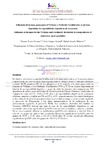Influencia de la masa grasa para el VO2max y umbrales ventilatorios en jóvenes deportistas de especialidades deportivas de resistencia

Use este enlace para citar
http://hdl.handle.net/2183/22748
Excepto si se señala otra cosa, la licencia del ítem se describe como Atribución-NoComercial-SinDerivadas 3.0 España
Colecciones
Metadatos
Mostrar el registro completo del ítemTítulo
Influencia de la masa grasa para el VO2max y umbrales ventilatorios en jóvenes deportistas de especialidades deportivas de resistenciaTítulo(s) alternativo(s)
Influence of fat mass for the VO2max and ventilatory thresholds in young athletes of endurance sport specialtiesFecha
2017Cita bibliográfica
Sportis, 2017, 3 (1):16-33 ISSN: 2386-8333
Resumen
[Resumen] El objetivo del estudio es analizar la influencia de la masa grasa total y su % respecto al peso corporal total, así como la masa grasa regionalizada (Σ pliegues tronco, Σ pliegues abdomen, cociente TS/TI, phantom (Ph) de los pliegues) y su % respecto a la masa grasa total, en relación al VO2max y los Umbrales Ventilatorios (VT1 y VT2) en jóvenes deportistas en función de su especialidad deportiva y grupo de edad. La muestra está compuesta por 400
deportistas de ambos sexos del Centro de Tecnificación de Cheste (Valencia) clasificados en
3 grupos de edad: <12-13, 14-16 y 17-20 años, y de especialidades deportivas de resistencia:
atletismo, natación y triatlón (n=134, n=135 y n=131 respectivamente). Los datos fisiológicos
se han obtenido de un test ergoespirométrico incremental en rampa en cinta rodante siguiendo
el protocolo de Wasserman; y los datos antropométricos de la realización de una
antropometría siguiendo el protocolo ISAK. Los resultados derivados del Análisis de
Varianza (ANOVA) indican que para el caso de las especialidades deportivas se han
encontrado diferencias significativas (p<0,05) entre atletismo y triatlón, y natación y triatlón.
No se han encontrado diferencias significativas (p>0,05) entre atletismo y natación. Para el
caso de los grupos de edad se han encontrado diferencias significativas (p<0,05) entre los
grupos de 14-16 y 17-20 años, y <12-13 y 14-16 años. No se han encontrado diferencias
significativas (p>0,05) entre los grupos de <12-13 y 17-20 años [Abstract] The aim of the study is to analyse the influence of total fat mass and its % regarding total body weight, as well as the regionalized fat mass (Σ trunk folds, Σ abdominal folds, ratio TS/TI, phantom (Ph) of the folds) and its % regarding total fat mass in relation to VO2max and ventilatory thresholds(VT1, VT2) in young according to their sport specialty and age group. The sample is composed of 400 athletes of both sexes from Centro de Tecnificación de Cheste (Valencia) classified into 3 age groups: <12-13, 14-16 and 17-20 years of age, and endurance sports disciplines: athletics, swimming and triathlon (n = 134, n = 135 and n = 131 respectively). The physiological data was obtained from and ergospirometric incremental ramp test on a treadmill following the Wasserman protocol; and the anthropometric data from an anthropometric measurement following the ISAK protocol. The results obtained from the Variance Analysis (ANOVA) indicate significant differences (p<0,05) for the case of sport specialties, those being athletics, swimming and triathlon. But there were no significant differences (p<0,05) between athletics and swimming. For the case of age groups, the findings indicate significant differences (p<0,05) between the age groups 14-16 and 17-20, as well as <12-13 and 14-16 years of age. But this was not the case for the age groups <12-13 and 17-20 years of age.
Palabras clave
Consumo máximo de oxígeno
Edad
Especialidad
Masa grasa
Age
Fat mass
Maximum oxygen consumption
Specialty
Edad
Especialidad
Masa grasa
Age
Fat mass
Maximum oxygen consumption
Specialty
Derechos
Atribución-NoComercial-SinDerivadas 3.0 España
ISSN
2386-8333






